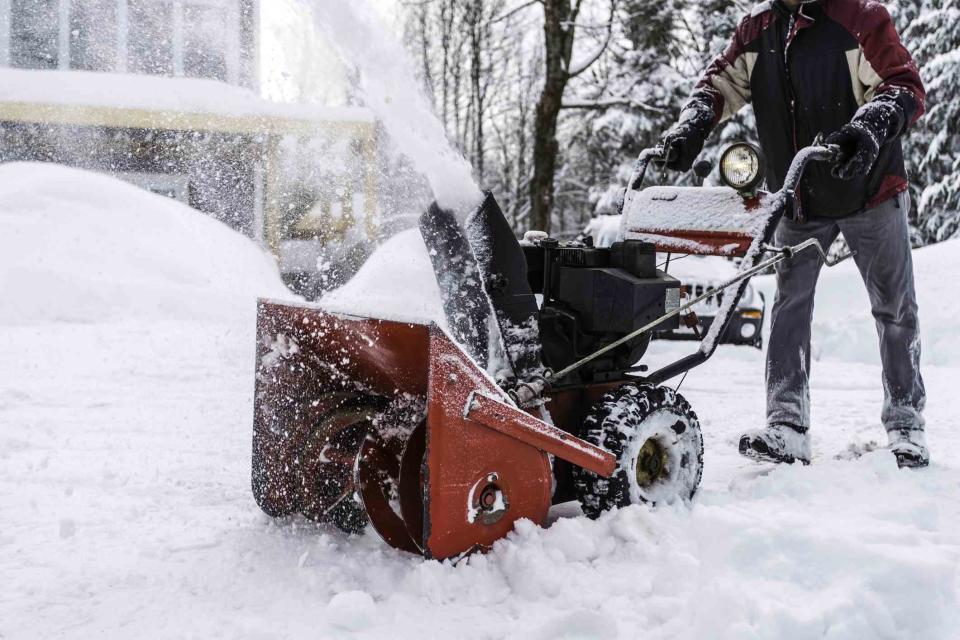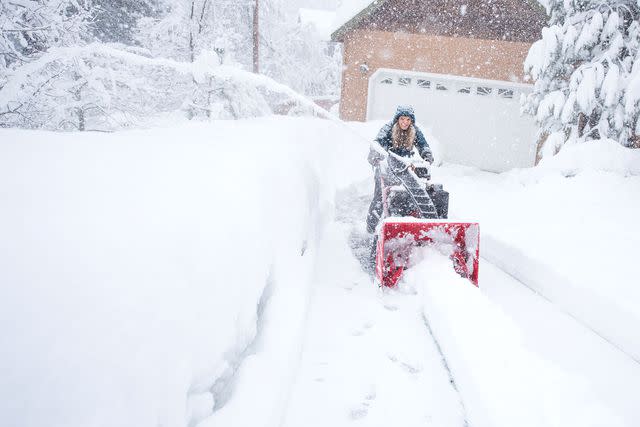How to Use a Snowblower to Clear Your Home's Walkways
Effectively and efficiently remove snow from driveways and paths.

Onfokus / Getty Images
Learning how to effectively use a snowblower will help you weather whatever winter throws your way. While most homeowner-grade snowblowers won't tackle massive snow banks, they can make quick work of clearing your driveway and sidewalk. However, there are a few tips and tricks for snow blowing that will help you maximize the functionality of your machine, while minimizing the amount of time you spend out in the cold. Once the season ends, proper storage will ensure your machine works year after year.
A snowblower, or snow thrower, is a machine with an adjustable, motor-driven auger that collects snow and propels it in a specified direction via a discharge chute.
Familiarize Yourself with Your Snowblower
Before heading out to the driveway, get to know your machine's controls. Identify what propels the machine forward and backward and how to engage the auger. Look for speed controls as well as controls for altering the direction of the discharge chute.
Inspect the Machine
Inspect your snowblower thoroughly before use, especially before the first use of the season. Here are a few key components to check:
Belts
Shear pins
Skid shoes
Tire pressure
Oil level
:
Prepare the Machine
After inspecting the machine, prepare it for use with the following checklist:
If you stored the machine with an empty gas tank, fill the tank. Unless otherwise specified, use only 100% ethanol-free gasoline.
If you left gas in the tank from the previous year, siphon it out before adding new gas.
Adjust the skid shoes for your surface. If blowing snow off a gravel driveway, lower the shoes to create plenty of clearance between the auger and the gravel. For a tighter pass on concrete or pavement, raise the skid shoes.
Wax the inside of the discharge chute to lower the potential for clogging.

Vernon Wiley / Getty Images
How to Use a Snowblower
Follow the steps below to make blowing snow off of your driveway or sidewalk a breeze.
Step 1: Plan Your Path
While it might seem simple enough to get straight to blowing snow off the driveway, planning your path beforehand will greatly increase your efficiency, as well as the quality of your end result. First, decide where you want the snow to end up, then plan your path around this goal. Always position the chute in a manner that discharges away from homes, cars, and people.
If you wish to pile snow on both sides of the driveway, starting in the middle and working outward will do the trick. If you desire just one pile of snow, starting on the opposite side and working toward the pile will be the most efficient path.
Step 2: Prep the Area
Prep the area by removing any sticks, rocks, or other debris that could damage your blower or pose a safety risk to you or others. While controlling the direction that the blower throws snow is fairly effective, foreign objects like rocks can easily be hurled beyond your intended target.
Step 3: Put on Safety Gear
Before starting your machine, put on safety gear. While you're likely already wearing your winter gloves, don't forget safety glasses and ear protection.
Step 4: Operate the Snowblower
Move the snowblower into position at the beginning of your path and engage the auger. Start at a low speed until you get the hang of things and maintain the low speed if the layer of snow is more than 7-9 inches. As you get more comfortable operating the blower, increase the speed.
Heavy snowdrifts can be more than most homeowner-grade snowblowers can handle. Always work in a manner that removes only a small amount of snow at a time and make multiple passes if necessary. For heavy snow, increase the engine speed while maintaining a low ground speed.
Step 5: Store the Snowblower
Between uses, thoroughly dry the machine before storing it to prevent rust. Before each use, inspect the components listed above. Consider using a fuel stabilizer to maintain the quality of your gas.
At the end of the season, follow these storage steps to ensure your machine is ready for the next season:
Wash and thoroughly dry the machine and address any rust spots. Remove the rust with a wire brush and sandpaper, then spray the affected area with a rust preventer.
Follow all manufacturer's guidelines for lubrication and proper storage practices.
Treat your engine with fogging oil to protect engine components during storage.
Siphon all gas from the machine and store the blower in a garage, shed, or otherwise covered area.
Tips for Maximizing Your Snow-Blowing Efforts
Always tackle the snow immediately after it has fallen. Snow that sits and has the opportunity to melt and refreeze is difficult to remove and can even damage your auger.
After the local snow plow passes, hit the pile left at the end of the driveway as soon as you can. Once this hardens into a glacier-like pile, most snowblowers can't handle it.
Waxing the chute and applying non-stick silicone spray to the auger can help prevent clogs.
Keep spare parts like belts and shear pins on hand so you can minimize downtime and stay ahead of the falling snow.
Mark the edge of your path with stakes for flags to make it easier to stay on track.

